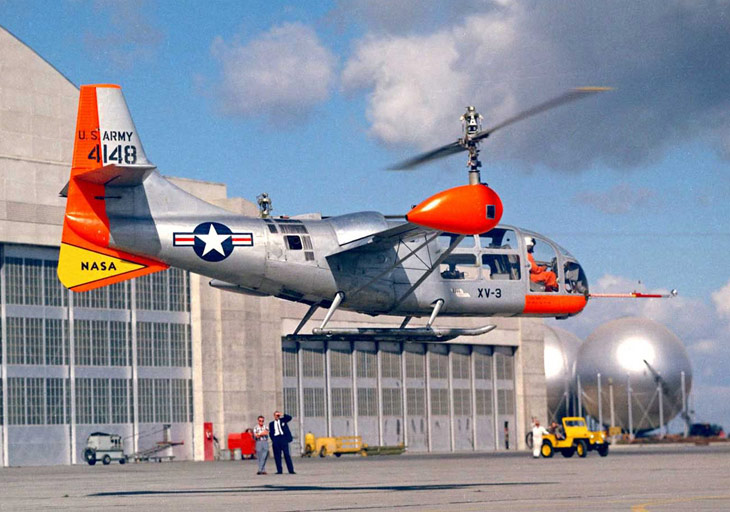Bell
XV-3 Tiltrotor Prototype
The Bell XV-3 was a prototype tiltrotor aircraft built in the 1950s.
It was a precursor to the modern Bell Boeing V-22 Osprey used by the
United States Air Force and Marine Corps.
The Bell XV-3 was a joint research program between the USAF and the
US Army. It was the result of a 1951 design brief from the US military
for a 'Convertible Aircraft Program'. In 1953 the successful Bell
design was approved with an order for two prototypes.
The aircraft resembled a cross between a helicopter and a conventional
fixed-wing aircraft. The glazed cockpit and forward section of the
fuselage resembled a helicopter. While the tail section and stubby
wings were more like an airplane. On the end of each wing was a small
nacelle which housed the the rotors. The engine was inside the fuselage
and drove the rotors via drive shafts concealed within the wings.
The aircraft was originally classed as a helicopter, and given the
designation XH-33, but this was later changed to the better known
XV-3 name. Later the name was officially changed once again to the
XV-3A.
The Bell XV-3 first flew on August 11 1955. Just a week later, on
the 18th, the aircraft suffered a heavy landing as the result of a
instability with the rotor system. It wasn't until March 1956 that
the aircraft returned to the skies after extensive modifications and
a new round of ground tests.
Unfortunately the instability flaw occurred in July 1956, resulting
in the aircraft being grounded again while Bell engineers conducted
further investigations. Flight testing resumed in September, but less
than a month later the aircraft was destroyed in an accident. The
test pilot, Dick Stansbury, survived but was severely injured. The
cause of the accident was attributed to the pilot blacking out due
to extremely high cockpit vibrations when the rotor shafts were rotated
forward.

After the accident, the second Bell XV-3 prototype was modified yet
further. The three-bladed propeller was changed for a two-bladed design.
This improved design resulted in a faster and generally more stable
aircraft.
But the same instability problems reared their head yet again in May
1958 during an attempted vertical to forward flight transition. The
aircraft was grounded yet again. This time the XV-3 was taken to the
NASA Ames wind tunnel for extensive testing. Data collected from analysis
of the aircraft in the wind tunnel resulted in the rotor diameter
being reduced, the wings being strengthened, and the rotor controls
being made stiffer.
This final round of modifications were definitive. Flight testing
resumed in December 1958, and on the 18th Bell test pilot Bill Quinlan
achieved the first stable full conversion from helicopter mode to
airplane mode. In January 1959, Air Force Captain Robert Ferry became
the first US military pilot to complete a tiltrotor conversion. By
April of that year, testing of the aircraft by Bell came to an end
and the XV-3 was shipped to Edwards Air Force Base for military flight
testing. Robert Ferry, now a Major, coauthored the military report
on the aircraft, and noted that despite the obvious problems with
the XV-3's specific design, the idea of a tiltrotor aircraft for military
applications was good.
Following the US Military's testing of the XV-3, the prototype was
returned to the NASA Ames research facility where further testing
was conducted. In 1966, as part of a project trying to fully analyze
the initial rotor instability problems in an effort to prevent future
tiltrotor aircraft suffering the same problems, the Bell XV-3 was
returned to the wind tunnel for testing and to help develop a computer
model. Unfortunately while in the wind tunnel, during the very final
test, the a failure of the rotors resulted in severe damage to the
aircraft and also damage to the wind tunnel itself. The damage was
too extensive to make a repair to flying condition viable. In June
1966 the project was finally wrapped up.
In total the two Bell XV-3 prototypes had conducted over 250 flights,
resulting in 125 flight hours and 110 full conversions from vertical
to horizontal flight and back again. The XV-3 also validated the idea
of the tiltrotor aircraft and led to further, more advanced designs.
The surviving Bell XV-3 prototype was kept in storage for many years
until 2004 when it was restored to museum condition by Bell Helicopter
employees led by former XV-3 engineer, Charles Davis. The aircraft
is currently held at the National Museum of the United States Air
Force in Dayton, Ohio. |

